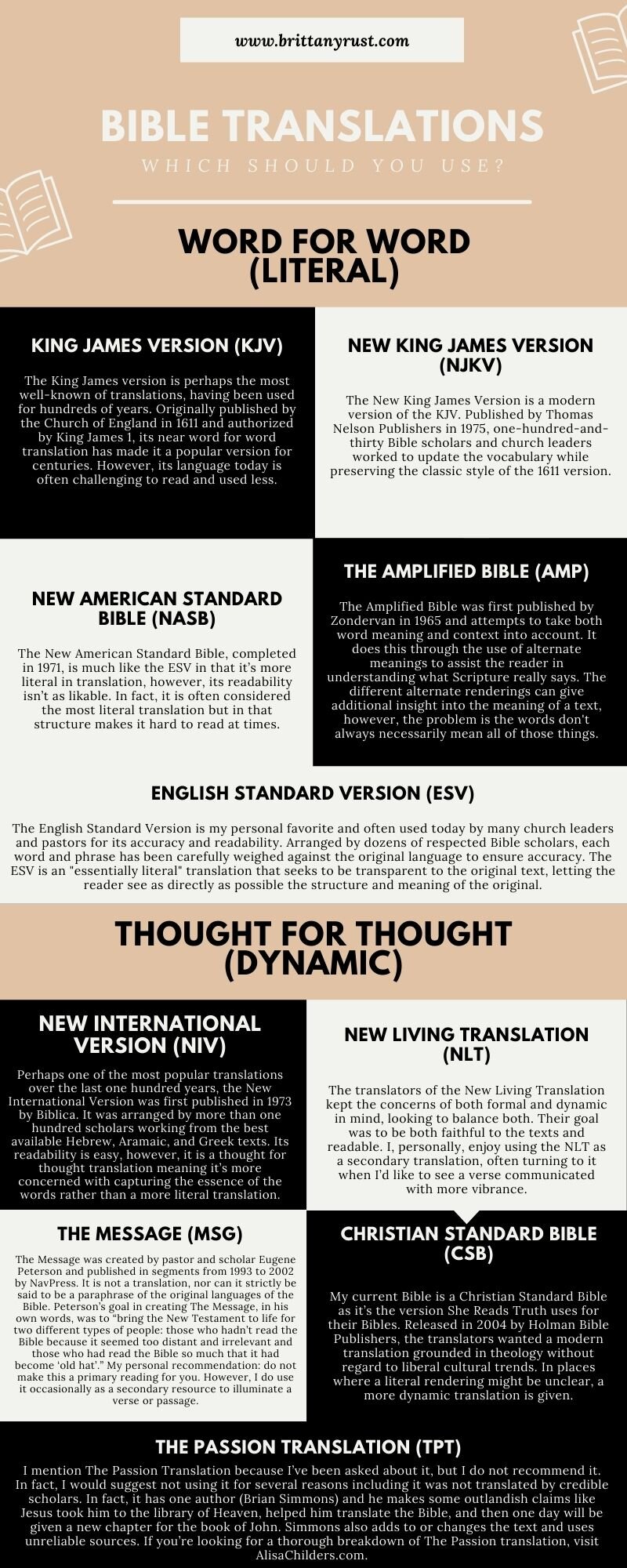Bible Translations: Which Should You Use?
Bible Translations Compared
There are many Bible translations out there and choosing one might seem a bit overwhelming. You’re not alone! I wondered the same thing as a young believer and it’s a question I often get today.
Let me start off by saying, there isn’t just one translation worth reading. The variations of language can be beautiful and enlightening, however, there are some that are more biblically sound than others.
For clarity, the Bible was not written in English, which is why it has been translated. The Old Testament was originally Hebrew and Aramaic, and the New Testament was originally Greek.
Now, a majority of Bible translations fall into two categories: word for word translation (literal) or thought for thought translation (dynamic).
Either the translation has attempted to translate word for word as much as possible, or rather focused on a general translation of the sentence that captures the essence while retaining accuracy.
For your primary Bible reading, I would encourage something closer to a literal translation. But sometimes I like to supplement with or look at a thought for thought to perhaps give me a different look at a passage.
With that said, let’s take a look at some of the most popular Bible translations and explore our options.
Word for Word Bible Translations
King James Version (KJV)
The King James version is perhaps the most well-known of translations, having been used for hundreds of years. Originally published by the Church of England in 1611 and authorized by King James 1, its near word for word translation has made it a popular version for centuries. However, its language today is often challenging to read and used less.
New King James Version (NKJV)
The New King James Version is a modern version of the KJV. Published by Thomas Nelson Publishers in 1975, one-hundred-and-thirty Bible scholars and church leaders worked to update the vocabulary while preserving the classic style of the 1611 version.
English Standard Bible (ESV)
The English Standard Version is my personal favorite and often used today by many church leaders and pastors for its accuracy and readability. Arranged by dozens of respected Bible scholars, each word and phrase has been carefully weighed against the original language to ensure accuracy. The ESV is an "essentially literal" translation that seeks to be transparent to the original text, letting the reader see as directly as possible the structure and meaning of the original.
New American Standard Bible (NASB)
The New American Standard Bible, completed in 1971, is much like the ESV in that it’s more literal in translation, however, its readability isn’t as likable. In fact, it is often considered the most literal translation but in that structure makes it hard to read at times.
Amplified Bible (AMP)
The Amplified Bible was first published by Zondervan in 1965 and attempts to take both word meaning and context into account. It does this through the use of alternate meanings to assist the reader in understanding what Scripture really says. The different alternate renderings can give additional insight into the meaning of a text, however, the problem is the words don't always necessarily mean all of those things.
Thought for Thought Bible Translations
New International Version (NIV)
Perhaps one of the most popular translations over the last one hundred years, the New International Version was first published in 1973 by Biblica. It was arranged by more than one hundred scholars working from the best available Hebrew, Aramaic, and Greek texts. Its readability is easy, however, it is a thought for thought translation meaning it’s more concerned with capturing the essence of the words rather than a more literal translation.
New Living Translation (NLT)
The translators of the New Living Translation kept the concerns of both formal and dynamic in mind, looking to balance both. Their goal was to be both faithful to the texts and readable. I, personally, enjoy using the NLT as a secondary translation, often turning to it when I’d like to see a verse communicated with more vibrance.
The Message (MSG)
The Message was created by pastor and scholar Eugene Peterson and published in segments from 1993 to 2002 by NavPress. It is not a translation, nor can it strictly be said to be a paraphrase of the original languages of the Bible. Peterson’s goal in creating The Message, in his own words, was to “bring the New Testament to life for two different types of people: those who hadn’t read the Bible because it seemed too distant and irrelevant and those who had read the Bible so much that it had become ‘old hat’.” My personal recommendation: do not make this a primary reading for you. However, I do use it occasionally as a secondary resource to illuminate a verse or passage.
Christian Standard Bible (CSB)
My current Bible is a Christian Standard Bible as it’s the version She Reads Truth uses for their Bibles. Released in 2004 by Holman Bible Publishers, the translators wanted a modern translation grounded in theology without regard to liberal cultural trends. In places where a literal rendering might be unclear, a more dynamic translation is given.
The Passion Translation (TPT)
I mention The Passion Translation because I’ve been asked about it, but I do not recommend it. In fact, I would suggest not using it for several reasons including it was not translated by credible scholars. In fact, it has one author (Brian Simmons) and he makes some outlandish claims like Jesus took him to the library of Heaven, helped him translate the Bible, and then one day will be given a new chapter for the book of John. Simmons also adds to or changes the text and uses unreliable sources. If you’re looking for a thorough breakdown of The Passion translation, visit AlisaChilders.com.
Best Bible Translation
Is there a “best” one? It’s not my place to say. However, if I were to recommend one I would choose the ESV. Its literal translations coupled with easy to read language makes it a favorite in my book.
Bible Translations to Avoid
I would definitely recommend avoiding The Passion translation for many of the reasons stated above. I also wouldn’t suggest making The Message a primary translation but do enjoy it for occasional secondary reading.
Bible Translations Chart
Here is a helpful chart supplied by God’s Word.
Source: www.godsword.org/pages/bible-translation-guide
Best Bible Commentaries and Sources
Another question I occasionally get is one of commentary recommendations. I honestly don’t know all the commentators and theologians out there, but I do recommend the following:
Warren Wiersbe
Warren W. Wiersbe was a well known international Bible teacher who served as pastor of Moody Church in Chicago and General Director and Bible Teacher for Back to the Bible. Dr. Wiersbe authored more than 80 books, including the best-selling "BE" series.
Blue Letter Bible
Blue Letter Bible is a free resource, both online and as an app, that provides valuable study tools such as word translation and meanings, as well as commentary from respected theologians.
John Lindell
John Lindell is the lead pastor of James River Church in Ozark, Missouri. While he does not have commentaries he does preach verse by verse through books of the Bible. You can find his sermons at JamesRiver.church.
I often will look at commentaries from Charles Spurgeon, Matthew Henry, and John MacArther (although I don’t hold the same beliefs as MacArthur regarding the gifts of the Holy Spirit and women in ministry).
For websites, be careful of the sources you find. There are many voices and thoughts out there and it can be a bit misleading. I like sources such as Desiring God, Precept Austin, Logos, and Gospel Coalition. If you're not sure, do some research on the site and author first.



